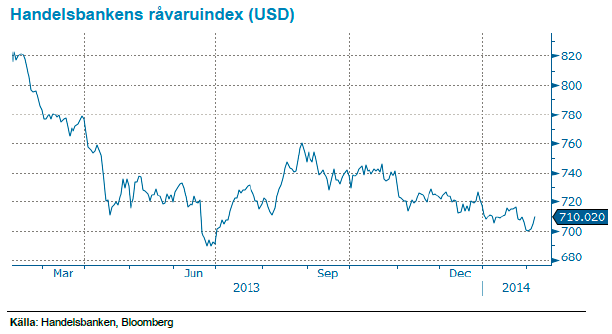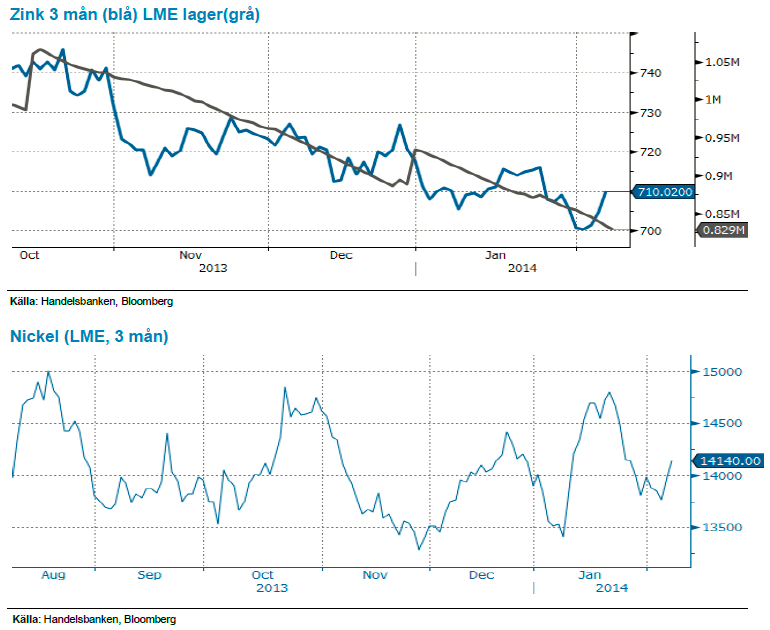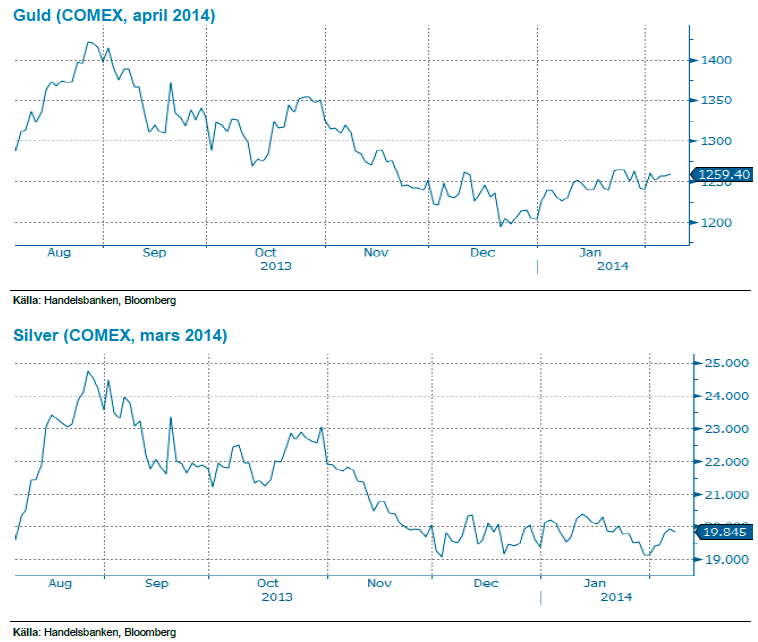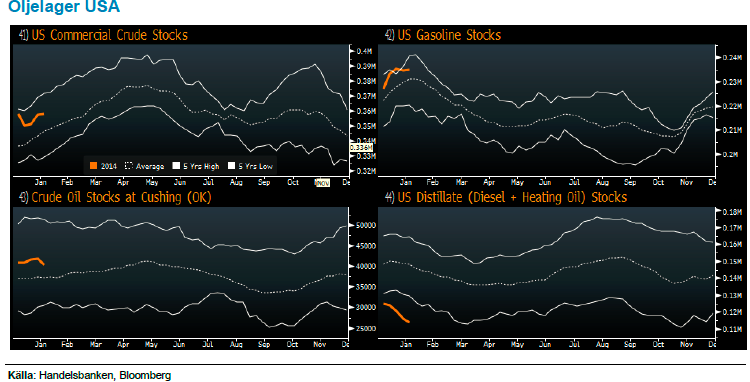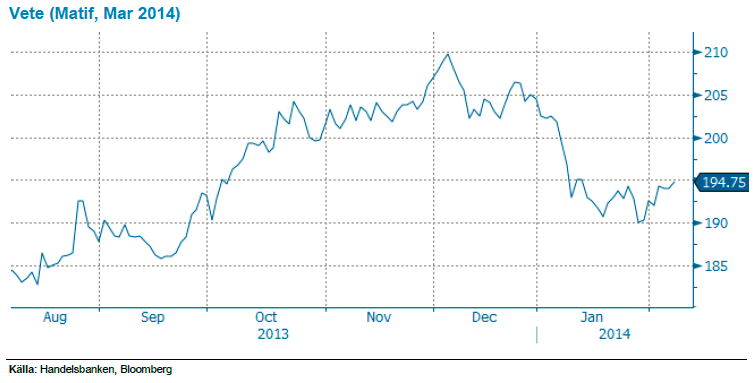Analys
SHB Råvarubrevet 7 februari 2014

 Råvaror allmänt: Oron tilltar
Råvaror allmänt: Oron tilltar
De senaste veckornas tumultartade utveckling i utvecklingsekonomierna har denna vecka spetsats till av att USA:s inköpschefsindex, ISM, föll dramatiskt i januari. Även fredagens non-farm payrolls överraskade negativt med 113 000 nya jobb mot väntade 180 000. Tillsammans med Kinas avmattning hjälper det föga att data i Europa har fortsatt bra. Investerare har helt plötsligt fått mycket ny oro att fundera över.
Endast tre gånger sedan 1990 har ISM fallit med mer än 5 enheter (5,2 i januari), vid varje tillfälle (2001, 2008, 2011) har ISM rättvist förutspått en inbromsning i konjunkturen. Det återstår att se hur februarisiffran kommer ut i mars före vi vet hur det blir denna gång. Om detta är startskottet på en ny besvikelse för återhämtningen kommer snart Fed under luppen. Vägen dit kantas dock av fallande marknader. Senaste åren har visat att råvaror också upplevt fallande priser när risktillgångar handlats ner.
Även om den kinesiska utvecklingen behöver lite tid efter nyårsfirandet för att dömas tror vi att uppsidan i drakens revir är liten. Tillväxtmålet för 2014 ska annonseras i mars men redan har 9 av de 22 provinserna annonserat lägre mål än under 2013. Tillsammans med de finansiella riskerna som nyligen blossat upp lägger de tillväxtkostande reformbehoven locket på för starkare efterfrågan på råvaror.
Basmetaller: Uppgångar, trots svagt Kina
Kina fortsätter att leverera svag data, inköpschefsindex för både tjänste- och tillverkningsindustrin föll under januari från föregående månad, i linje med vad marknaden förväntat sig. Trots svag data från både Kina och USA har metallerna klättrat uppåt under veckan. Zink sticker ut med sina 2,2 % medan övriga ligger runt procenten.
Japans största zinkproducent, Mitsui Mining & Smelting CO., höjer sina priser med 70 % för internationella köpare på grund av ökad efterfrågan från Kina. Globala produktionen väntas stramas åt under 2014 vilket ger stöd till priset. Zinklager på LME har fallit drastiskt under hösten och fortsätter att falla även efter årsskiftet, ned 11 % YTD.
Nickelpriset stöds fortsatt av exportförbudet i Indonesien och är den metall vi tror mest på. I övrigt håller vi en neutral vy för basmetallssektorn där vi ser uppsidan som begränsad då Kinas efterfrågan på metallen inte räcker till.
Låga prisnivåer, exportstopp av oförädlad nickelmalm från Indonesien och det faktum att 40 % av gruvorna går med förlust på dagens prisnivå. Vi tror på: LONG NICKEL H
Ädelmetaller: Emerging markets oro ger stöd
Den gångna veckan har präglats av fortsatt osäkerhet runt emerging markets, men både börser och valutor har återhämtat sig ganska bra. Trots detta har guldet – och i än högre grad ”lillebrorsan” silvret – stärkt sig. Guldet har i skrivande stund stärkts med 1,5 procent, och silver med nära 4 procent. Även platina och palladium har stigit, så hela ädelmetallsektorn har presterat bra – trots att riskaptiten återhämtat sig under veckan.
Även flödet till ETF-marknaden (för guld) är lätt positivt. Vi ser allt det som – om än litet – tecken på att vår nyligen påtagna positiva syn på ädelmetallsektorn. Vi tror alltjämt att konsensus runt guldet nu är negativt, och därmed positioneringen, och ser vi förnyad oro kring emerging markets så finns god potential för prisstegringar på samtliga ädelmetaller.
Efter en lång tid av negativ vy för guldet har vi bytt fot och tror på stigande pris. Vi tror på: LONG GULD H
Energi: Strejk vid oljeterminaler i Frankrike
Oljemarknaden stärks marginellt under veckan där en svagare dollar, strejk vid oljeterminaler i Frankrike samt en något stramare marknad för Nordsjöolja är några bidragande faktorer. Veckans amerikanska lagersiffror (se nedan) planar ut något för både råolja och bensin men heating oil faller i samband med den stränga kylan i Nordamerika.
I övrigt har det varit mest fokus på gasmarknaden som stiger väldigt kraftigt då kylan ser ut att bita sig fast under resten av februari. Brentoljan handlas i stort sett oförändrat över de senaste tre åren, i snitt 110.01 år 2011 och 111.68 år 2012 samt 108.70 år 2013, och vi har svårt att se vad som skall driva den ur detta intervall. Vår vy står därför fast, nivåer kring 106 är köpvärda med tanke på en ständigt närvarande oro kring MENA:s oljeproducerande länder. Däremot får man se potentialen på uppsidan som begränsad till en ca 4-5 dollar eftersom marknaden är i bra balans, USA producerar på höga nivåer samtidigt som utbudssituationen i Libyen ser ut att förbättras ytterligare.
För elen öppnade veckan starkt för de korta kontrakten, för att sedan backa tillbaka efter blötare prognoser.
Vintern verkar dröja och prognoserna visar på fortsatt milt väder med plusgrader och en nederbörd om 6,5 TWh väntas. Veckans snackis är utsläppsrätterna som haft en fantastisk utveckling och som stigit ytterligare 20 procent på bara en vecka (40 procent senaste månaden). Igår torsdag röstade man äntligen ja till att korta ner processen på backloading, som innebär att man drar tillbaka 400 miljoner rätter redan i år. Vi seren begränsad risk på uppsidan för utsläppsrätterna då det nu i huvudsak återstår ett godkännande av processen. Det milda vädret fortsätter att hålla priserna på både kol och gas nere. Kolet finner stöd efter att världens största kolexporthamn Richards Bay haft svårt att få ut tonnage då man dragits med problem kring elförsörjning hela januari. Detta förväntas vara åtgärdat under veckan som kommer.
Vi tror att det kommer ges möjligheter till god avkastning i denna range-baserade handel där oljan är köpvärd var gång den kommer ned på lägre nivåer. Vi tror på: LONG OLJA H
Livsmedel: Risk för utvintring är inte över
Priset på vete har gått upp under veckan dels på grund av att en del av USA:s höstveteregioner har upplevt kallt väder vilket skapat viss oro för utvintring. I mitten av nästa vecka väntas dock varmare väder igen. Nederbörd önskas innan grödan kommer ur vintervilan då stora delar är relativt torra. EU är milt och ganska blött, torrare i öst, och utan oro för grödorna som uppges vara i gott skick.
Rysslands jordbruksminister meddelade i veckan att på 95,5 procent av den höstsådda arealen är grödorna i gott eller i tillfredställande skick. Fina grödor alltså men glöm inte att arealen är omkring 10 procent mindre än året innan som följd av dåligt väder vid tid för sådd – vilket spås kunna kompenseras delvis av en ökad vårsådd. Ukraina har blivit lite varmare igen och även fått lite mer snö och risken för eventuell utvintring bedöms som liten. Det finns gott om vete (och annan spannmål) att tillgå i världen, dock försvåras tillgången av ganska stora logistikproblem – inte minst i Kanada som har svårt att få tågvagnar och andra transportsystem att klara av den stora skörden. Logistikproblem och fortfarande viss oro för utvintring begränsar för tillfället möjligheten till fallande priser. De grödor som såtts för skörd senare i år är dock i stort sett överallt i gott skick och vi tror det kommer krävas något lite mer allvarligt väderproblem för att inte trenden med fallande priser ska fortsätta. Vi håller en neutral vy för livsmedelssektorn där vi är neutrala till jordbruksprodukterna men positiva till de exotiska (apelsin juice, kakao, kaffe).
Vi ser allvarligt på bakteriesjukdomen som härjar i Florida och ökad spridning hotar att slå ut apelsinträden i år framöver. Vi tror på: BULL APELS X2 H
Handelsbankens råvaruindex
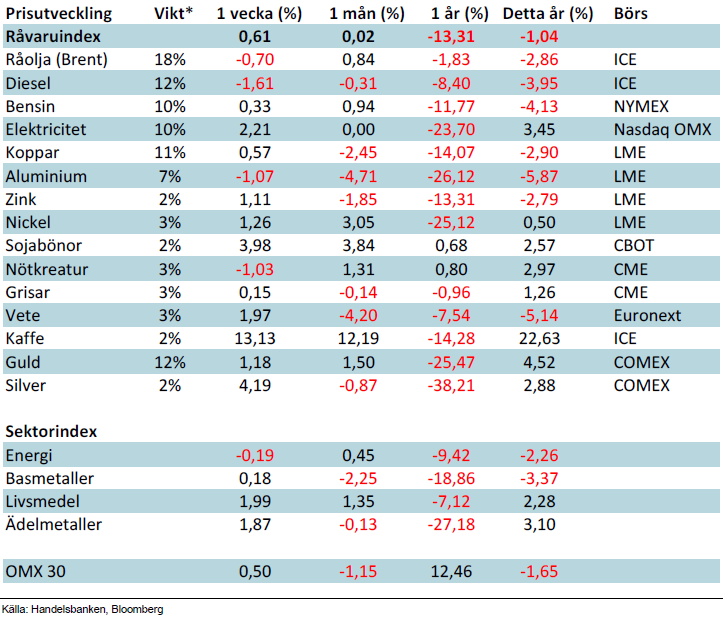
*Uppdaterade vikter från 29 november 2013
Handelsbankens råvaruindex består av de underliggande indexen för respektive råvara. Vikterna är bestämda till hälften från värdet av nordisk produktion (globala produktionen för sektorindex) och till hälften från likviditeten i terminskontrakten.
[box]SHB Råvarubrevet är producerat av Handelsbanken och publiceras i samarbete och med tillstånd på Råvarumarknaden.se[/box]
Ansvarsbegränsning
Detta material är producerat av Svenska Handelsbanken AB (publ) i fortsättningen kallad Handelsbanken. De som arbetar med innehållet är inte analytiker och materialet är inte oberoende investeringsanalys. Innehållet är uteslutande avsett för kunder i Sverige. Syftet är att ge en allmän information till Handelsbankens kunder och utgör inte ett personligt investeringsråd eller en personlig rekommendation. Informationen ska inte ensamt utgöra underlag för investeringsbeslut. Kunder bör inhämta råd från sina rådgivare och basera sina investeringsbeslut utifrån egen erfarenhet.
Informationen i materialet kan ändras och också avvika från de åsikter som uttrycks i oberoende investeringsanalyser från Handelsbanken. Informationen grundar sig på allmänt tillgänglig information och är hämtad från källor som bedöms som tillförlitliga, men riktigheten kan inte garanteras och informationen kan vara ofullständig eller nedkortad. Ingen del av förslaget får reproduceras eller distribueras till någon annan person utan att Handelsbanken dessförinnan lämnat sitt skriftliga medgivande. Handelsbanken ansvarar inte för att materialet används på ett sätt som strider mot förbudet mot vidarebefordran eller offentliggörs i strid med bankens regler.
Analys
Tightening fundamentals – bullish inventories from DOE

The latest weekly report from the US DOE showed a substantial drawdown across key petroleum categories, adding more upside potential to the fundamental picture.

Commercial crude inventories (excl. SPR) fell by 5.8 million barrels, bringing total inventories down to 415.1 million barrels. Now sitting 11% below the five-year seasonal norm and placed in the lowest 2015-2022 range (see picture below).
Product inventories also tightened further last week. Gasoline inventories declined by 2.1 million barrels, with reductions seen in both finished gasoline and blending components. Current gasoline levels are about 3% below the five-year average for this time of year.
Among products, the most notable move came in diesel, where inventories dropped by almost 4.1 million barrels, deepening the deficit to around 20% below seasonal norms – continuing to underscore the persistent supply tightness in diesel markets.
The only area of inventory growth was in propane/propylene, which posted a significant 5.1-million-barrel build and now stands 9% above the five-year average.
Total commercial petroleum inventories (crude plus refined products) declined by 4.2 million barrels on the week, reinforcing the overall tightening of US crude and products.


Analys
Bombs to ”ceasefire” in hours – Brent below $70

A classic case of “buy the rumor, sell the news” played out in oil markets, as Brent crude has dropped sharply – down nearly USD 10 per barrel since yesterday evening – following Iran’s retaliatory strike on a U.S. air base in Qatar. The immediate reaction was: “That was it?” The strike followed a carefully calibrated, non-escalatory playbook, avoiding direct threats to energy infrastructure or disruption of shipping through the Strait of Hormuz – thus calming worst-case fears.

After Monday morning’s sharp spike to USD 81.4 per barrel, triggered by the U.S. bombing of Iranian nuclear facilities, oil prices drifted sideways in anticipation of a potential Iranian response. That response came with advance warning and caused limited physical damage. Early this morning, both the U.S. President and Iranian state media announced a ceasefire, effectively placing a lid on the immediate conflict risk – at least for now.
As a result, Brent crude has now fallen by a total of USD 12 from Monday’s peak, currently trading around USD 69 per barrel.
Looking beyond geopolitics, the market will now shift its focus to the upcoming OPEC+ meeting in early July. Saudi Arabia’s decision to increase output earlier this year – despite falling prices – has drawn renewed attention considering recent developments. Some suggest this was a response to U.S. pressure to offset potential Iranian supply losses.
However, consensus is that the move was driven more by internal OPEC+ dynamics. After years of curbing production to support prices, Riyadh had grown frustrated with quota-busting by several members (notably Kazakhstan). With Saudi Arabia cutting up to 2 million barrels per day – roughly 2% of global supply – returns were diminishing, and the risk of losing market share was rising. The production increase is widely seen as an effort to reassert leadership and restore discipline within the group.
That said, the FT recently stated that, the Saudis remain wary of past missteps. In 2018, Riyadh ramped up output at Trump’s request ahead of Iran sanctions, only to see prices collapse when the U.S. granted broad waivers – triggering oversupply. Officials have reportedly made it clear they don’t intend to repeat that mistake.
The recent visit by President Trump to Saudi Arabia, which included agreements on AI, defense, and nuclear cooperation, suggests a broader strategic alignment. This has fueled speculation about a quiet “pump-for-politics” deal behind recent production moves.
Looking ahead, oil prices have now retraced the entire rally sparked by the June 13 Israel–Iran escalation. This retreat provides more political and policy space for both the U.S. and Saudi Arabia. Specifically, it makes it easier for Riyadh to scale back its three recent production hikes of 411,000 barrels each, potentially returning to more moderate increases of 137,000 barrels for August and September.
In short: with no major loss of Iranian supply to the market, OPEC+ – led by Saudi Arabia – no longer needs to compensate for a disruption that hasn’t materialized, especially not to please the U.S. at the cost of its own market strategy. As the Saudis themselves have signaled, they are unlikely to repeat previous mistakes.
Conclusion: With Brent now in the high USD 60s, buying oil looks fundamentally justified. The geopolitical premium has deflated, but tensions between Israel and Iran remain unresolved – and the risk of missteps and renewed escalation still lingers. In fact, even this morning, reports have emerged of renewed missile fire despite the declared “truce.” The path forward may be calmer – but it is far from stable.
Analys
A muted price reaction. Market looks relaxed, but it is still on edge waiting for what Iran will do

Brent crossed the 80-line this morning but quickly fell back assigning limited probability for Iran choosing to close the Strait of Hormuz. Brent traded in a range of USD 70.56 – 79.04/b last week as the market fluctuated between ”Iran wants a deal” and ”US is about to attack Iran”. At the end of the week though, Donald Trump managed to convince markets (and probably also Iran) that he would make a decision within two weeks. I.e. no imminent attack. Previously when when he has talked about ”making a decision within two weeks” he has often ended up doing nothing in the end. The oil market relaxed as a result and the week ended at USD 77.01/b which is just USD 6/b above the year to date average of USD 71/b.

Brent jumped to USD 81.4/b this morning, the highest since mid-January, but then quickly fell back to a current price of USD 78.2/b which is only up 1.5% versus the close on Friday. As such the market is pricing a fairly low probability that Iran will actually close the Strait of Hormuz. Probably because it will hurt Iranian oil exports as well as the global oil market.
It was however all smoke and mirrors. Deception. The US attacked Iran on Saturday. The attack involved 125 warplanes, submarines and surface warships and 14 bunker buster bombs were dropped on Iranian nuclear sites including Fordow, Natanz and Isfahan. In response the Iranian Parliament voted in support of closing the Strait of Hormuz where some 17 mb of crude and products is transported to the global market every day plus significant volumes of LNG. This is however merely an advise to the Supreme leader Ayatollah Ali Khamenei and the Supreme National Security Council which sits with the final and actual decision.
No supply of oil is lost yet. It is about the risk of Iran closing the Strait of Hormuz or not. So far not a single drop of oil supply has been lost to the global market. The price at the moment is all about the assessed risk of loss of supply. Will Iran choose to choke of the Strait of Hormuz or not? That is the big question. It would be painful for US consumers, for Donald Trump’s voter base, for the global economy but also for Iran and its population which relies on oil exports and income from selling oil out of that Strait as well. As such it is not a no-brainer choice for Iran to close the Strait for oil exports. And looking at the il price this morning it is clear that the oil market doesn’t assign a very high probability of it happening. It is however probably well within the capability of Iran to close the Strait off with rockets, mines, air-drones and possibly sea-drones. Just look at how Ukraine has been able to control and damage the Russian Black Sea fleet.
What to do about the highly enriched uranium which has gone missing? While the US and Israel can celebrate their destruction of Iranian nuclear facilities they are also scratching their heads over what to do with the lost Iranian nuclear material. Iran had 408 kg of highly enriched uranium (IAEA). Almost weapons grade. Enough for some 10 nuclear warheads. It seems to have been transported out of Fordow before the attack this weekend.
The market is still on edge. USD 80-something/b seems sensible while we wait. The oil market reaction to this weekend’s events is very muted so far. The market is still on edge awaiting what Iran will do. Because Iran will do something. But what and when? An oil price of 80-something seems like a sensible level until something do happen.
-

 Nyheter3 veckor sedan
Nyheter3 veckor sedanStor uppsida i Lappland Guldprospekterings aktie enligt analys
-

 Nyheter4 veckor sedan
Nyheter4 veckor sedanBrookfield ska bygga ett AI-datacenter på hela 750 MW i Strängnäs
-

 Nyheter4 veckor sedan
Nyheter4 veckor sedanSommaren inleds med sol och varierande elpriser
-

 Nyheter4 veckor sedan
Nyheter4 veckor sedanOPEC+ ökar oljeproduktionen trots fallande priser
-

 Nyheter3 veckor sedan
Nyheter3 veckor sedanSilverpriset släpar efter guldets utveckling, har mer uppsida
-

 Analys4 veckor sedan
Analys4 veckor sedanBrent needs to fall to USD 58/b to make cheating unprofitable for Kazakhstan
-

 Nyheter4 veckor sedan
Nyheter4 veckor sedanTradingfirman XTX Markets bygger datacenter i finska Kajana för 1 miljard euro
-

 Nyheter2 veckor sedan
Nyheter2 veckor sedanUppgången i oljepriset planade ut under helgen


